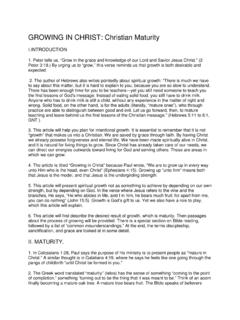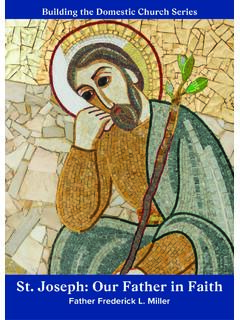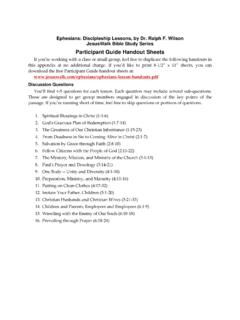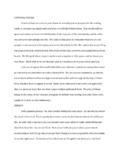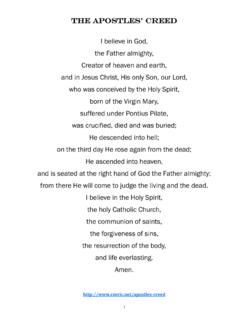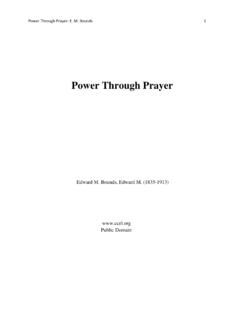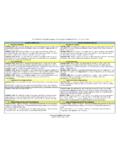Transcription of Faith, Spirituality, and Religion: A Model for ...
1 102 NEWMAN faith , Spirituality, and Religion: A Model for Understanding the Differences Leanne Lewis Newman* The terms faith , spirituality, and religion are often used interchangeably, though their definitions are unique and distinct. This article discusses the nuanced differences among the three terms. It presents a Model for the interrelatedness among the three important constructs and suggests ways the Model can be used for further research. " faith " is nearly impossible to define. It means something different to each individual. faith is understood to be intensely personal and often seen as extremely private. "The term ' faith ' ranges in meaning from a general religious attitude on the one hand to personal acceptance of a specific set of beliefs on the other hand" (Hellwig, 1990, p. 3). Yet faith is still superimposed on the lives of our students (Newman, 1998). Though most often seen in religious terms, faith remains an "extraordinarily important construct" (Lee, 1990, p.)
2 Vii). Despite the mandate from the Student Personnel Point of View (American Council on Education, 1937) to develop the whole person as part of the student affairs profession, a relative silence has permeated the faith dimension of student development. Even with the advent of Fowler's (1981) faith development theory, it has taken until well into the 1990s for student development researchers to begin investigating faith development of college students. Within the past few years, however, researchers have called on our profession to begin focusing on this dimension of students' development (Love & Talbot, 1999; Temkin & Evans, 1998). With this call comes the responsibility to make clear distinctions as to the specific focus of our inquiry. The terms faith , spirituality, and religion frequently appear either side by side or are even used synonymously for one another. In fact, the focus of this special issue uses all three terms in the title, including all three as equal parts.
3 While there is merit to including all three terms for investigating issues and areas of students' development, a distinction should also be made when discussing these three important and interrelated concepts. In this issue alone, we discuss religion, spirituality, and faith , and the developmental issues involved with each. Yet, when we discuss one, are we really talking about another? Where is the overlap of one to the other? Or are we really lumping all three into the same construct? * Leanne Lewis Newman is a lecturer in the student services administration graduate preparation program at Baylor University. Correspondence concerning this article should be sent to Leanne THE COLLEGE OF STUDENT AFFAIRS JOURNAL 103 faith , Spirituality, Religion Model Both Fowler (1981) and Parks (1986, 2000) have offered a fairly comprehensive notion of the term faith . Other researchers have taken their ideas and placed them in the context ofstudent development (Love, 2001, 2002; Love & Talbot, 1999).
4 Both Love (2001) and Nash (2001) discuss the differences between religion and spirituality. While Love suggests that religion and spirituality overlap, he does not delve further as to why or how. Nash makes the distinction by saying that spirituality is an inward expression, while religion is an outward expression of faith . While both Love and Nash attempt to define the terms, I feel there is more to understanding these important differences. First, I will discuss the three concepts of faith , spirituality, and religion. Then, I will propose a Model for understanding the nuanced differences among them. faith and faith Development As a part of sociological research, faith development has been virtually absent until the last 10 years (Hiebert, 1992). In fact, according to Hiebert, faith development as a citation was not present in Sociofile, the computer index of sociological journal articles, until the middle of 1989.
5 Interestingly, faith -defined as a general religious attitude or accepted set of personal beliefs -was not present in the ancient worlds of Greek and Roman culture. Rather, the concept of faith singularly and directly originates in the Hebrew scriptures (Hellwig, 1990). Hellwig traces the notion of faith through the New Testament, the Church Fathers, the Middle Ages, the Reformation, and into the Modern Era. faith has been a part of religion, and explored by scholars from numerous disciplines (Hellwig, 1990). However, as Hiebert (1993) points out, Fowler (1981) departs from these conventional notions of faith and "equates faith with individual meaning systems" (p, 321). "Fowler describes the most generic and most profound process of being human, the process of meaning-making, as faith . faith , in his conception, is therefore often but not necessarily religious" (p. 321). In his introduction, Fowler (1981) discusses how faith : is so fundamental that none of us can live well for very long without it, so universal that when we move beneath the symbols, rituals and ethical patterns that express it, faith is recognizably the same phenomenon in Christians, Marxists, Hindus and Dinka, yet it is so infinitely varied that each person's faith is unique.
6 (p, xiii, emphasis original) Tying together the uniqueness of individual faith into a workable and plausible theoretical framework, Fowler is careful at numerous times throughout not to confuse it with religion. Fowler describes faith in human terms. "Prior to our being religious or irreligious .. we are already engaged with issues of faith . Whether we become nonbelievers, SPRING 2004 -VOLUME 23, NUMBER 2 SPECIAL ISSUE ON faith , SPIRITUALITY, AND RELIGION ON CAMPUS 104 NEWMAN agnostics or atheists, we are concerned with how to put our lives together and with what will make life worth living" (p. 5), In fact, Fowler spends the entirety of Part I (pp, 3-36) of his foundational work Stages ofFaith (1981) describing what faith is. He takes enormous care to point out the differences among faith , religion, and belief. Additionally, he discusses faith and relationship, and faith and imagination. Specifically, he stresses the concept of "radical monotheism.
7 " Although monotheism is traditionally held to be the "doctrine or belief that there is only one God," (Fowler, 1981, p. 22) as in Jewish, Christian, and Islamic traditions, he broadens the concept to be a relation "in which a person or group focuses its supreme trust and loyalty in a transcendent center of value and power, that is neither a conscious or unconscious extension of personal or group ego nor a finite cause or institution" (p. 23). This implies a singular loyalty to the "principle of being and to the source and center of all value and power' (p. 23, emphasis original). In addition to being universal, faith is relational, implying the trust of one upon another (Fowler, 1981, 1986a, 1986b). faith is also seeing and knowing. "Knowing occurs when an active knower interacts with an active world of persons and objects, meeting its unshaped or unorganized stimuli with the ordering, organizing power of the knower's mind" (Fowler, 1986b, p.)
8 19). Another important concept to understand is Fowler's concept of faith and imagination, specifically what he calls the "ultimate environment" (p. 24). The ultimate environment is the means by which we find order and shape our actions based on what we see going on around us. As imagination, faith forms a comprehensive unit of what we see in our ordered world and deposits value and power in it with regard to self, others, and world. Symbols and metaphors can bring the shared images of an ultimate environment together as expression. Often unconscious or tacit within a community, the ultimate environment poses a tremendous influence in a person's response to life. Fowler adds that faith exhibits the qualities of a mystery , rather than a problem. " faith .. is perplexing, because we are internal to it" (1981, p. 32, emphasis original). '''Objectivity' about faith inevitably involves our 'subjectivity.
9 ' While I have tried at various points to pull definitions of faith together, I have never sought to oversysternatize it into a manageable concept," Fowler writes (1986a, p. 281). Tam (1996) concludes that "any attempt to reduce Fowler's understanding of faith to any simple definition is in fact doing injustice to his theory" (p. 252). Fowler (1986b) provides a summary, composite definition as: faith is the process of constitutive-knowing; underlying a person's composition and maintenance of a comprehensive frame (or frames) of meaning; generated from the person's attachments or commitments to centers of supraordinate value which have power to unify his or her experiences of the world; thereby endowing the relationships, contexts, and patterns of everyday life, past and future, with significance. (pp. 25-26) THE COLLEGE OF STUDENT AFFAIRS JOURNAL 105 faith , Spirituality, Religion Model Succinctly stated, faith "has to do with the making, maintenance, and transformation of human meaning" (Fowler, 1986b, p.)
10 15). This definition of faith naturally leads to a discussion of faith development. faith development is new to the psychology of religion (Nipkow, Schweitzer, & Fowler, 1991). And, as the limited citations in education and sociology journals prove, it is new to those areas as well. According to Nipkow, Schwietzer, and Fowler, faith development is not about one type of faith or religion, but it refers to the "developmental process of finding and making meaning as a human activity" (p. 1). As has already been noted by Fowler (1981, 1986b), it is "equally applicable to religious and nonreligious, Christian and non-Christian interpretations of self and world" (Nipkow, Schweitzer, & Fowler, 1991, p. 1). Further, faith development is a psychological concept, distinct from anyone particular belief. At the same time, faith development can be seen "in such a way that it can also be interpreted theologically and filled with substantive beliefs" (p.











